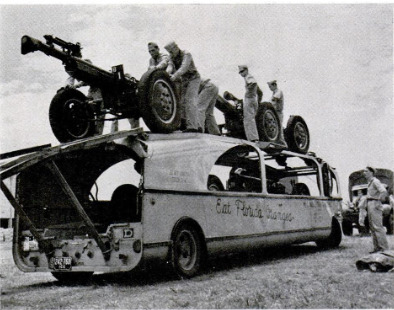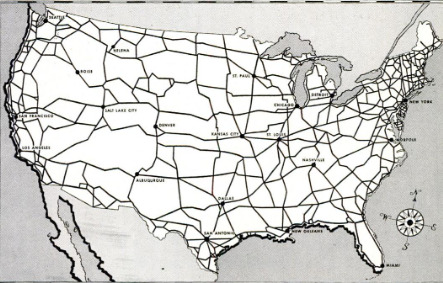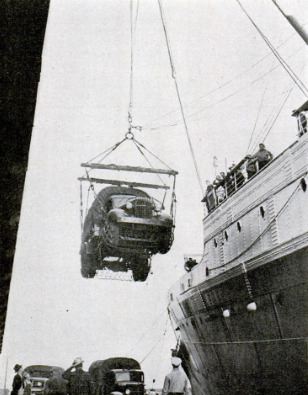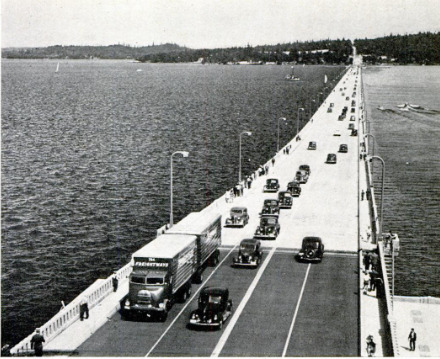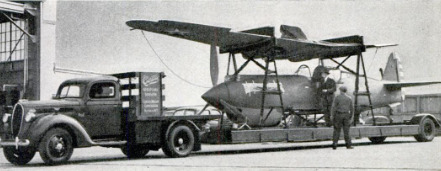-
Title (Dublin Core)
-
Ready to roll transportation organizations to meet defense needs
-
Article Title and/or Image Caption (Dublin Core)
-
Title: Ready to roll transportation organizations to meet defense needs
-
extracted text (Extract Text)
-
TROOPS and tanks, planes and bombs,
Tem and ammunition are all mighty
words in the language of the defense
program of the United States. But mightier
than all of them is the key word: “Trans-
portation.”
That is why President Roosevelt, in call-
ing upon leading industrialists to help co-
ordinate the nation's greatest peacetime
military effort, included a veteran railroad
man with a reputation for getting things
done.
Men, materials, and machines, the three
essential ingredients of modern military
power, are worthless unless the nation pos-
sessing them has a transportation system
capable of getting them where they are
needed at the time they are needed.
It is part of the task of the National De-
fense Advisory Commission to see that
America gets the most out of its railroads,
its highways, its air lines, its waterways,
and its pipe lines during the industrial mo-
bilization, and to plan just how all those
systems should function if they had to be
used during a conflict.
We have something to work with—no
doubt about that. This country has more
trains running over more miles of railroad
than any other nation. It has more miles of
commercial airways, more automobiles, and
more motor trucks than any other world
power. It has more miles of hard-surface
roads, of inland waterways, and of pipe lines
for petroleum products.
But we have also the knowledge that a
transportation system just as great for its
time bogged down pretty badly during the
World War, and it is up to the Commis-
sion’s representative of transportation to
see that that doesn’t happen again.
His job on the N. D. A. C. is divided into
two parts—the first the industrial mobiliza-
tion end and the other the plan for war
emergency.
On the first, the program should antici-
pate nation-wide and local transportation
needs as far in advance as possible, and
then should get the various carriers to
transport defense materials and men with-
out delaying the normal commercial busi-
ness of the country.
In war, of course, civilian needs would be
subordinated to military needs. But bar-
ring actual invasion, it is probable that
even war would not disrupt ordinary ship-
ments—provided plans had been made
wisely.
With wise planning as its goal, the Com-
mission has added to its staff representa-
tives of each type of transportation—men
who may fight each other to the last ditch
for business but who are working together
wholeheartedly in codrdinating transporta-
tion for patriotic purposes.
They've already guarded against one of
the worst tangles that marred transporta-
tion during the World War. Failure of
freight receivers to unload cars promptly
and the Governments wholesale and some-
times senseless use of priorities were the
chief causes of the bogging down of the
railroads in the war winter of 1917-18. Be-
cause of lack of codrdination between rail
and overseas transportation loaded cars
piled up in the terminals of eastern sea-
ports. The tangle was made worse by gov-
ernment. contractors ordering large quanti-
ties of materials which they wouldn't need
for weeks and which they had no place to
store when they received it. At one time
there were 5,000 carloads of piling for the
Hog Island shipyard clogging the Philadel-
phia yards, with the fanciful trimming of a
number of cars loaded with anchors for
ships whose keels hadn't been laid. Eventu-
ally there were over 200,000 loaded freight
cars—nine out of ten of them plastered
with red priority tags—serving as ware-
houses on wheels in railroad yards along the
eastern seaboard, and causing a shortage
of 150,000 cars in other sections of the
country and a traffic jam which extended
west of Pittsburgh. The snarl wasn't
cleared until all freight into the congested
area was embargoed while the misused cars
were being unloaded and the yards cleaned
out.
Now, because of that sad memory, the
Army and Navy Munitions Boards specify
that railroad cars must not be loaded with
defense materials unless it is known that
they can be unloaded promptly at their des-
tination.
The railroads are able to exercise the
same power to prevent tie-ups through the
operation of a well-tested embargo system.
Congestion in seaboard areas is averted by
their port control organization. It is notable
that last year the North Atlantic ports
handled more than three quarters as much
export business as they did in 1918, and
handled it without delay. It is notable, too,
that there hasn't been a car shortage since
1922.
Another step to help make certain that no
such shortage ever develops in any defense
emergency is a coordinated warehousing
program to eliminate the World War prac-
tice of using cars for storage. At key points,
ample space will be provided for storing
materials that cannot be absorbed by the
defense industries as soon as delivered.
The N. D. A. C. estimates that the na-
tional defense program, including additional
steel production, plant expansion, and camp
construction, plus the maintenance of a
large army and a possible increase in com-
mercial freight caused by better business,
will result in a maximum traffic increase of
less than 50,000 carloads a week.
That would be about eight percent of the
average weekly car loadings in 1939. In
that year, in one five-month period, car
loadings increased by 55 percent. Yet even
in the peak month of October, with an
average of 843,736 cars a week handled, the
railroads had an average daily surplus of
66,000 serviceable cars. That surplus would
be enough to take care of the defense in-
crease. But already 25,000 new cars have
been bought—and so that end of the job
will work out all right.
As important an asset as the railroads is
the nation’s network of a million miles of
hard-surface roads.
The War Department considers 75,000
miles of them to be of strategic importance.
But—14,000 of these are deficient in the
surface strength necessary to support heavy
loads; more than 4,000 miles should be
widened, and for military purposes most of
the strategic roads meed shoulders every
two miles at which truck convoys can park.
Bringing these roads up to the standard
desired by the Army will be an expensive
project, but it is a necessary one. Just as
necessary are the building of 3,000 miles of
access roads for camps, military posts, and
new industrial plants, and the construction
of city connections for strategically im-
portant highways.
Highways are already doing their full
share in carrying the industrial-mobiliza-
tion traffic, and as the defense load grows,
so will their importance increase. The
N. D. A. C. is aware that the value of the
roads would be heightened by uniformity
of regulations for trucks in the various
states. That's another problem that may
be solved.
Inland waterways play a part in the de-
fense program because
of the heavy cargoes of
ore, coal, grain, and oil
that can be sent to key
points in their barges.
We now have 17,000
miles of improved inland
waterways which are
more than four feet
deep, and the barge lines
which use them are in-
creasing in importance
as freight carriers. Most
of this traffic is on the
Mississippi, Missouri,
Ohio, and Illinois rivers
and on New York's Hud-
son Barge Canal, but
there also are barge
lines on the Sacramento,
Columbia, Snake and
other Pacific Coast riv-
ers, and on a few east-
ern and southern water-
ways. But in spite of
the growth of this busi-
ness the Great Lakes
whaleback steamers,
which transport heavy
cargoes of ore, coal,
grain and oil from May
to mid-December remain
by far our most impor-
tant inland water-borne
carriers.
Pipe lines move an
equivalent of 3,330,000
carloads of petroleum
and its products each
year. Since gasoline and
oil are the lifeblood of modern mechanized
warfare, this underground transportation
network would play a vital part in any con-
flict and, even in time of peace, contributes
greatly to our defense preparations by re-
leasing railroad, truck, and shipping ca-
pacity for other purposes.
Another great asset is our highly de-
veloped system of air lines. In addition to
mail and passenger traffic, express service is
increasing so greatly that there is talk of
establishing an out-and-out cargo-carrying
line.
They're all part of the defense program—
just as much a part as are machine guns
and artillery.
And because that’s true, the millions of
workers on the transportation lines have
become civilian soldiers in the mobilization
of America’s resources.
-
Language (Dublin Core)
-
Eng
-
Date Issued (Dublin Core)
-
1941-02
-
pages (Bibliographic Ontology)
-
82-85
-
Rights (Dublin Core)
-
Public domain
-
Archived by (Dublin Core)
-
Sami Akbiyik
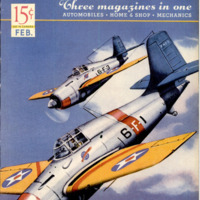 Popular Science Monthly, v. 138, n. 2, 1941
Popular Science Monthly, v. 138, n. 2, 1941

